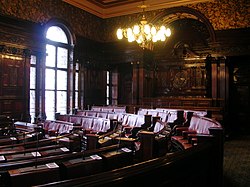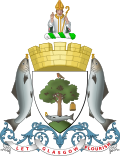| Glasgow City Chambers | |
|---|---|
 The front of the City Chambers, from George Square | |
 | |
| General information | |
| Type | Municipal building |
| Architectural style | Victorian |
| Address | George Square G2 1DU |
| Town or city | Glasgow |
| Country | Scotland |
| Coordinates | 55°51′40″N4°14′55″W / 55.8610°N 4.2486°W |
| Construction started | 1882 |
| Completed | 1888 |
| Owner | Glasgow City Council |
| Design and construction | |
| Architect(s) | William Young |
| Other designers | John Mossman and George Lawson (sculptors) |
| Main contractor | Morrison and Mason |
| Other information | |
| Public transit access | |
| Website | |
| Official website | |
Listed Building – Category A | |
| Designated | 15 December 1970 |
| Reference no. | LB32691 |
The City Chambers or Municipal Buildings in Glasgow, Scotland, has functioned as the headquarters of Glasgow City Council since 1996, and of preceding forms of municipal government in the city since 1889. It is located on the eastern side of the city's George Square. It is a Category A listed building. [1]







